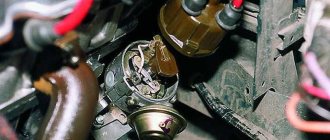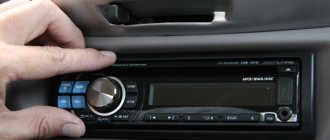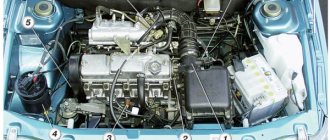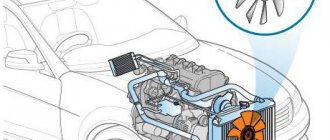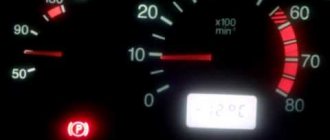Why is there no spark on the ignition coil, where to look for a fault? If there is no spark, it is recommended to first inspect the blocks and wires of the ignition system. If there is water, dirt or oil on the wires or block, wipe them with a dry cloth. Then try to start the engine, maybe this time it will start. If the engine does not start, inspect the high voltage wires.
It is important to know that the wires should not be frayed, they should be neat without breaking the insulation. If any violations are detected in the insulation, the wires are replaced with new ones. Next, we check all the contacts; to do this, just rub them with your hand. No spark? Then perhaps the fault lies in the spark plugs that do not work, perhaps there is a short to ground, the wires of the low voltage circuit are broken, the ignition coil or the distribution breaker is out of order. Start looking for a spark in the spark plug wires, remove the tip of the spark plug wire from the spark plug and bring the tip to the ground at a distance of five to eight millimeters (the nearest metal part of the car that is not touched by paint), then turn on the starter for a few seconds. Pay attention to the starter.
When the starter rotates, there should be a continuous bright white spark with a faint blue tint. If the spark is red, yellow or purple, then we can say that the car's ignition system is in a faulty state. Still no spark? Then check the ignition coil. To check the ignition coil, you need to pull out the central wire that comes from the coil from the distributor-breaker cover.
With the starter rotating, by analogy with the spark plugs, we check the spark from the wire. If a spark appears, then the ignition coil is in good condition, and the fault is most likely in the distributor. If a spark does not appear, then the ignition coil is most likely faulty or there is an open circuit in the low voltage circuit. Troubleshooting the breaker-distributor Carefully inspect the cover of the breaker-distributor from the inside. If the cover is in good condition, then it is enough to wash it with gasoline. If cracks are visible on the cover, it is replaced with a new one.
To check whether the central carbon contact of the breaker-distributor is stuck, just move it with your finger. To check the integrity of the rotor insulation of the breaker-distributor, you need to lay out the central high-voltage wire from the rotor electrode with a gap, then, with the ignition on, close and open the contacts of the breaker by hand. If sparks appear in the gap, then we can talk about a rotor malfunction. In this case, the rotor is replaced. To check the low voltage circuit, you will need a 12-volt test lamp with a power of no more than 3 watts. The lamp is connected on one side to the low voltage terminal, and on the other side it is connected to the vehicle ground.
Checking for spark
When the engine of a fuel-injected VAZ 2107 refuses to start, it is simply wrong to blame the spark plugs for this malfunction. First you need to make sure that this is the problem, and only after that find out the reasons for the malfunction of the ignition system. Not all drivers know how to check the spark on a fuel-injected car. But this is not a difficult procedure, which will 100% allow you to find out where to look for the reason for the inability to start the engine.
Checking for a spark on the spark plugs is done in the following ways:
- The easiest way to check is by mass. It can be implemented by performing the following actions - turn off the ignition, unscrew each spark plug one by one, and connect it to the spark plug and place it on the metal part of the engine. In this case, one person tries to start the engine, and the second watches for the presence of a spark.
- There is another method, which involves using a special candle tester. Its principle is based on the fact that the spark plug must be unscrewed from the cylinder and connected to the contacts of the tester. The spark must come from the device itself.
A weak spark or its absence indicates that the reason the engine does not start lies precisely in the spark-creating device. If there is a weak spark, the engine may start, but it will be unstable. Unstable operation also negatively affects its operational life. The absence of a spark does not mean that the cause of the malfunction is in the spark plug. The cause may also be a malfunction of the vehicle's ignition system.
What are the causes of problems with spark formation?
It is easier to identify the reasons for the lack of spark formation on a carburetor engine than on an injector. This is due to the design features and differences between these systems. There is a list of reasons for problematic sparking on injection cars, in particular on the VAZ 2107. Some of them are similar to carburetor systems. These reasons are the following factors:
- Filling spark plugs with fuel. Such a malfunction can be identified visually after unscrewing the device from the cylinder. In this case, the contact part will be wet.
- Failure of the spark plug, which is also detected by visual inspection of the contact part. The presence of black or white carbon deposits indicates some engine malfunction. If the carbon deposits on the spark plug are red or pink, this indicates that the fuel used contains a large amount of additives.
- Breakdown of high-voltage wires. Their malfunction can be determined visually, but the absence of mechanical defects does not always indicate their unsuitability. Over time, the quality of insulation deteriorates, and the resistance in the wires also increases, so it is recommended to replace high-voltage wires every 5 years.
- Malfunction of electronics, in particular the ECU. The reason why the spark plugs are flooded may be a faulty lambda probe sensor.
- Clogged injector nozzles. For this reason, the injector will also not work correctly, since there will be a lot of fuel mixture in the combustion chamber, and it will interfere with the normal operation of the engine.
- Malfunction of such elements of the ignition system as the switch, ignition coil, crankshaft sensor. If these parts fail, there will be no spark at all.
If there is no spark on all spark plugs or it is very weak, then you should check the serviceability of other devices. If there is no spark on only one part, then there is a high probability that it is faulty. You can verify this by screwing in a known good spark plug instead of a faulty one. If such experience confirms that it is the spark plug that is faulty, then it is advisable to replace all 4 elements.
This is interesting! To identify the exact reason why there is no spark on the VAZ 2107 injection engine, it is recommended to conduct computer diagnostics. If error code P03XX is displayed on the on-board computer, this indicates a malfunction in the ignition system.
Bringing the car back to life
Often, restoring engine performance due to a lack of spark in the spark plug on a VAZ 2107 is not particularly difficult. Usually this does not require digging deep, and it is enough to replace the sparking devices or armored wires to restore stable engine operation. You can resort to computer diagnostics only if a visual examination does not give a positive result. Depending on what the visual or computer diagnostics showed, it is necessary to take appropriate measures to bring the car back to life.
Many people simply do not pay enough attention to the timely replacement of spark plugs and armored wires. This ultimately leads to adverse consequences. Injection VAZ 2107 cars are more sensitive to various failures, therefore, if there are any, errors and engine inoperability occur. To determine why the engine on the seven does not start, it is recommended to check the following components:
- Candles and armored wires.
- Ignition module. To check it, you must install a known-good unit.
- Make sure that the control unit transistors are in good condition. It happens that the transistors burn out, which leads to the disappearance of the spark. Computer diagnostics will help you find out if transistors are faulty.
- Check the flow of the fuel mixture into the cylinders. If the fuel pump does not pump when the ignition is turned on, the engine will not start due to lack of fuel supply.
- Check the supply voltage at the injectors, for which you will need a multimeter.
- Check the pressure in the fuel rail using a pressure gauge.
Sevens with injection engines are very popular, but problems that arise with the ignition and fuel supply systems are more difficult than with carburetor models. You shouldn’t rush to go to a car service center, since it’s quite possible to fix this type of breakdown yourself.
Diagnostics
To understand which part of the starter the breakdown occurred in, you should thoroughly clean it. First, the solenoid relay is checked. If it is working properly, a loud click will be heard. Another evidence of the serviceability of this mechanism is that the bendix moves slightly forward. The absence of a click indicates that the relay is broken and needs to be replaced with a new one.
If the problem is not in this part, then you need to make sure that all the insulation is in good condition. All damage can be restored with impregnating varnish and then checked with special electrical measuring instruments.
When, after a complete inspection, all parts are found to be in good condition, the rotor insulation must be checked. Traces of burning and soot on the anchor indicate that this device needs to be replaced. The collector must be clean, free of deposits, and if this defect is present, you can clean the element with sandpaper. After all procedures, the coupling is checked. It should spin freely in one direction and be locked in the other.
Engine does not start - no spark
Everything that concerns the injection classics - nozzles, firmware, sensors and other headaches that carburetor owners are deprived of
sergiox Car enthusiast Messages: 31 Registered: Fri Sep 02, 2011 13:59:22 Car model: VAZ 21074, 2007, engine 1.6, BSZ, jasper color, Engine type: Injection From: Russia, Omsk Thanked by: 34 times Contact information:
Engine does not start - no spark
Unread message sergiox » Sun Nov 06, 2011 17:06:04
VAZ 21074, 2007, injector, contactless ignition system.
On Friday I drove a car, it was snowing, the temperature was 0..+1, there was a lot of humidity. By evening the temperature dropped to ...-4. I didn't touch the car on Saturday. On Sunday, my trunk lock was seized (WD-40 saved me), the doors did not open with the key fob the first time, I had to open it with the key. But I started the car the first time, it started without problems, it ran for about five minutes, I turned it off. In min. 30 started it again, ran it a little and turned it off again.
On Monday morning it wouldn't start. I turn on the ignition, wait until the pump is running for 3-4 seconds, then the relay clicks, I turn the key - the starter turns, but the engine doesn’t start, it doesn’t even start at all. So several attempts and without success. This is the first time, this has never happened before.
I checked the fuel system, or rather the pressure. On the fuel rail, I pressed the fitting for the pressure gauge and turned on the starter - a jet hit, that is, fuel flows to the injectors - and the spark plugs are dry - which means the injectors do not open, and no signal comes to them.
Replaced DPKV - did not help.
I removed the wire from the spark plug of the third cylinder - inserted a spare spark plug and secured it to ground - no spark.
What else would you recommend to watch? I really hope it's not the ECU.
sergiox
Violent General of the Automotive Troops semerka.info Messages: 40652 Registered: Thu Dec 11, 2008 17:11:37 Car model: Priora station wagon. There was a whole range of “classics”. Engine type: Injection From: Krasnodar region, Khadyzhensk Thanked: 2250 times Thanked: 4632 times
Re: Engine won't start - no spark
Unread message Violent » Sun Nov 06, 2011 17:33:40
sergiox wrote: I really hope it’s not the ECU.
We, too.
sergiox wrote: What else would you recommend to watch?
Move the low-voltage connector on the ignition module. If
Rustem wrote: Have you checked the spark on cylinders 2-4?
It’s not there, then... Unsubscribe first.
Violent
sergiox Car enthusiast Messages: 31 Registered: Fri Sep 02, 2011 13:59:22 Car model: VAZ 21074, 2007, engine 1.6, BSZ, jasper color, Engine type: Injection From: Russia, Omsk Thanked by: 34 times Contact information:
Re: Engine won't start - no spark
Unread message sergiox » Mon Nov 07, 2011 4:44:45 AM
Rustem wrote: sergiox 2-4 cylinders did you check the spark?
Not yet. I thought if there was no spark on the third cylinder, then there wouldn’t be one on cylinders 1, 2-4.
I'll try to check.
sergiox
zombie177rus Eternal Memory! Messages: 12668 Registered: Thu Oct 27, 2011 13:50:40 Car model: VAZ2107, not much stock Engine type: Injection From: Moscow Thanked: 90 times Thanked: 1275 times
zombie177rus
sergiox Car enthusiast Messages: 31 Registered: Fri Sep 02, 2011 13:59:22 Car model: VAZ 21074, 2007, engine 1.6, BSZ, jasper color, Engine type: Injection From: Russia, Omsk Thanked by: 34 times Contact information:
Re: Engine won't start - no spark
Unread message sergiox » Wed Nov 09, 2011 3:00:10
To check the power supply, I disconnected the power connector from the ignition module and measured the voltage with the ignition on. It turned out to be zero. Further along the chain I reached the fuse box under the glove compartment.
The result is that the main relay fuse has blown (the outermost fuse on the left is 7.5A). The most annoying thing is that I thought about it several times, but didn’t check it because I thought that it couldn’t be responsible for the spark in particular. After the replacement the car started right up.
Conclusion: first check the fuses, and then the rest. Maybe someone will find my experience useful. Many thanks to everyone participating in the discussion!
sergiox
Why might there be no spark?
The list of situations in which there may be no spark in car spark plugs is very long; anything can affect this. Let's try to identify the most frequently occurring causes on the VAZ models 2109, 2114, 2110, 2106:
- weak battery charge;
- the problem is in the high-voltage wires;
- there are problems with the ignition coil;
- problems with the low voltage circuit;
- problems with the ignition distributor.
You should also pay attention to the quality of contacts and electrical components. The contacts, of course, can be checked quite easily by tugging them a little with your fingers. In addition, it is advisable to inspect all elements of the ignition system. If there is dirt, oil, or water on them, they must be wiped off immediately with a dry cloth. After this, you can try to start the car.
Checking the ignition coil
To diagnose the coil, you need to remove the main wire from the distributor cap. Next, we try to crank the starter to see a spark from the wire.
- A spark has formed - this indicates that the coil is working properly. So the problem is with the breaker.
- If there is no spark, the fault must be looked for in the ignition coil.
If it has been determined that the problem lies specifically in the ignition coil, then it will have to be replaced. In “middle-aged” VAZ cars, especially 2109, 2106, 2114, 2110, this phenomenon is by no means rare.
Checking the ignition distributor
If there is a possibility that the problem lies specifically in the breaker, then in order to make a diagnosis, you need to inspect its cover from the inside:
- Visually, the cover is intact and has no signs of damage - wash it, preferably with gasoline, and put it back in place.
- If there are any visible signs of breakage or if there are any cracks, the cover will need to be replaced.
You also need to check the central contact of the breaker for any “freezes”. This is easy to do: just move its carbon tip.
Another check that can and even needs to be done is checking the insulation of the breaker rotor. This is done like this:
- First, the central explosive cable is located at a distance of five to eight millimeters from the electrode.
- Next, you need to close and open the contacts several times. All this must be done with the ignition on.
If even the slightest spark jumps in this small gap, this indicates a rotor malfunction. In such situations, he is replaced.
Checking the low voltage circuit
To diagnose such a circuit, you can use a 12-volt test lamp with a power of up to three watts. This light bulb must be connected with one contact to the ground of the car, and the other to the low voltage terminal. After manipulating the connection manually, the contacts of the breaker are closed and the ignition is turned on. If the circuit is working properly, then when the contacts are closed, the light goes out, and when the contacts are open, it lights up. When this does not happen, you need to start looking for a problem in the coil winding or in the cables.
If the lamp is constantly on, this indicates one of the following types of malfunctions:
- The breaker contacts are heavily oxidized.
- The wire leading from the lever to the breaker terminal is broken.
- The wire that connects the housing to the movable disk is broken.
The oxidized wires need to be cleaned, after which the system will work. In any other case, more in-depth intervention is necessary.
Troubleshooting the ignition system
Malfunctions of the car’s ignition system are unpleasant because any of them is always accompanied by serious interruptions in the engine’s operation or its complete stop. The main sign of a malfunctioning ignition system is the complete absence or “weak” spark between the electrodes of the spark plugs. What to do if there is no spark, and where to look for it? Read about this and more in our material.
Most often, the spark disappears precisely at the moment when you need to go somewhere. In order not to push the car to the nearest car service center, it is important to understand what the operation of the ignition system depends on, then finding the missing spark will not cause any particular difficulties.
At the end of this article, watch the video instructions for finding a spark in the ignition system of VAZ cars.
No fuel supply
In addition to problems in the ignition system, the VAZ 2107 engine may experience difficulty starting if there is a problem with the fuel system. Since they are different for injection and carburetor internal combustion engines, the problem is solved differently.
On the injector
If an engine equipped with a fuel injection system does not start due to a lack of gasoline supply (there is enough gasoline in the tank), then the problem lies in the fuel pump.
When the driver turns on the car's ignition, he should hear the sound of the pump. At this moment, the pressure necessary for the operation of the fuel injectors is created in the line. If this sound is not heard, then the engine will not start or will constantly stall.
On the carburetor
If little or no gasoline flows into the carburetor, then checking the fuel pump in this case is a little more difficult. The procedure is performed in the following sequence.
- The fuel hose is disconnected from the carburetor and lowered into a separate clean container.
- Crank the starter for 15 seconds. During this time, at least 250 ml must be pumped into the container. fuel.
- At this moment, gasoline should pour out under slight pressure. If the stream is weak or does not exist at all, you can buy a fuel pump repair kit and replace the gaskets and membrane. Otherwise, the part is replaced.
As you can see, there are plenty of reasons for problematic engine starting on the VAZ 2107. Most of them can be diagnosed independently without the expense of troubleshooting at a service station. It is important to understand the operating principle of the ignition and fuel supply system. They work in a logical sequence and many faults do not require special electrical or mechanical knowledge to resolve.
Making sure the spark plugs are working
Most often, the spark disappears due to problems with one of the spark plugs, so we will test these parts first. You can even check it in the field. To do this, it is enough to have a known working candle with you. Testing is performed as follows:
- insert a new spark plug;
- crank the starter and check for a spark;
- If the new part works fine, then we simply leave it in place and start the engine.
In a situation where a working spark plug does not fire, more complex checks will be required.
Effect of temperature
Often the VAZ-2107 does not start in winter. This problem can be caused by the wrong choice of oil viscosity or its thickening in the gearbox. It becomes difficult for the starter to turn it in the system.
If the oil viscosity is not suitable, it may cause engine failure. Therefore, in cold weather you should be very careful when selecting lubricants. In winter, in order for the car to start quickly, you need to squeeze the clutch all the way. The mechanism will spin the gearbox shafts, preparing the car for movement.
It is in winter that compression problems are detected in the cylinders. It is necessary to remove the candles. Then a little oil is poured into the cylinders. Now you should try to start the car again. Next, the candles are returned to their place. Experienced car enthusiasts claim that this method almost always works.
Checking high voltage wires
After checking the contact spark plugs, we move further along the circuit and test the performance of the high-voltage wires. The instructions below will help you diagnose if the spark disappears on only one of the cylinders:
- swap the wires connected to the spark plugs;
- check for the presence of a spark;
- if it appears on the cylinder to which you transferred the new wire and disappears on the other, then the problem is in the cable. Therefore, the latter will need to be replaced.
In exactly the same way, the integrity of the central wire through which voltage is supplied to the ignition coil is checked. You can also try to press it harder against the transformer and distributor cap to restore contact.
No spark at the injector, no spark
789 Google+ If the engine does not start, but you can hear the fuel pump in the tank turning on and running, in this case the spark on the injector most likely has disappeared. To determine the malfunction, you need to check for the presence of a spark discharge on high-voltage wires. In this case, be sure to use a spark gap. If you check for a break in the presence of a spark by placing the wire at a certain distance from the ground of the car, the ignition module or controller may fail due to the appearance of a large self-induction current with a large spark gap. In addition, you can get quite noticeable and unpleasant sensations when receiving an electric shock when the insulation breaks down. In the case when you check the spark discharge by placing a spark plug with a high-voltage wire on it on the engine body, also due to poor contact of the spark plug body with ground, a large self-induction current can form, which will lead to damage to the controller or ignition module. The use of a spark gap is also more convenient, since most injection engines use static ignition distribution with the simultaneous supply of high voltage to two spark plugs.
It is not difficult to make a spark gap yourself; here you can find several examples.
A drawing of a spark gap for simultaneously checking a spark on four high-voltage wires and a photo for checking a spark on two high-voltage wires. After connecting the spark gap, crank the engine with the starter and observe the presence of a spark discharge. If the spark on the injector on one wire disappears, when high voltage is distributed simultaneously to two spark plugs, then this indicates a breakdown to ground of the wire or the output of the ignition coil (ignition module). If there is no spark at the same time on a pair of wires 1-4 or 2-3, then the ignition coil, ignition module or controller is faulty. Breakage of high-voltage wires also cannot be ruled out.
Checking ignition devices.
To check the integrity of high-voltage wires, it is necessary to check their resistance; it should not exceed 200 kOhm, and there should not be a large difference in resistance in a set of identical wires. To check the ignition coils or module, you need to check for the corresponding error codes in the controller's RAM. If the controller does not have a diagnostic function for the module or coils, then the easiest way is to replace the module with a known good one and repeat the test. If in this case there is no spark on the same wires, then the controller or the wires connecting it to the ignition coil (module) are faulty. When checking the presence of a spark discharge in a static ignition system with an ignition coil on each cylinder, if there is no spark on one of the coils, replace it with any serviceable one from any cylinder. If a spark appears, the coil is faulty, otherwise the controller or the wire connecting it to the coil is faulty. In the case when there is no spark discharge on any wire, it is necessary to check the presence of power on the ignition coil, and when using a module in the ignition system, also the presence of a minus. For example, on cars with an MP7 controller, you need to check for the presence of a plus on wire 68 by touching it with a test lamp connected to the minus and the presence of a minus on wire 66, with a test lamp connected to the plus. If the supply wires are in good condition, you need to check the serviceability of the crankshaft position sensor. This can be done in several ways, depending on the controller used and the vehicle. After turning on the ignition and stopping the fuel pump, if we start cranking the engine with the starter, if the sensor is working, the pump should turn on again. But it must be taken into account that some controllers turn on the fuel pump only when certain crankshaft speeds are reached. You can also connect a test lamp to the terminals of any injector. In this case, during rotation of the crankshaft, if the sensor is working, the warning lamp should flash. If the sensor is working, then the controller or the wires connecting it to the ignition coils or module are faulty. Evidence of the operation of the crankshaft position sensor can be provided by damp spark plugs removed from the engine cylinders. A controller malfunction in 99% of cases is associated with a breakdown of the control key (transistor), which connects the primary winding of the ignition coils to the minus. This is the same main reason for the malfunction of the ignition module. But if the ignition module is filled with compound and is practically beyond repair, then the controller can be repaired in this case. In some cases, anyone with soldering iron skills and a little knowledge of electronics can handle this. A sensor malfunction is quite a rare occurrence and is often associated with loss of contact in the plug connection to the sensor, due to its contamination and oiliness, and a break or short circuit of the wires, due to improper installation during repairs.
If during the check it is determined that a spark is supplied to the spark plugs, but the engine does not start, then read the article “Injection engine does not start”
admin 06/03/2012 “If you notice an error in the text, please highlight this place with the mouse and press CTRL+ENTER” “If the article was useful to you, share the link to it on social networks”
avtolektron.ru
We check the ignition module of the 16-valve VAZ-2112 with a multimeter
The float is knocking in the tank of a VAZ 2107 injector
The situation is as follows: for no apparent reason the engine began to “trouble”, the thrust was lost, and the idle now does not even reach 500. I removed the high-voltage wires one by one, and so, there was no spark at all in cylinders 2 and 3. The engine is 16-valve, but without “individual coils”. The question is how to check the ignition module on a VAZ-2112 engine, and it is advisable not to remove it. Inside the module, in addition to the coils, electronics are installed. How can I check if it's working properly?
Checking the VAZ-2112 ignition module with your own hands
Inside the ignition module there is such a board
It is clear that we are talking about the 21120 engine and the ignition module 2112-3705010. By the way, there will be two more numbers in the article numbers - they indicate the manufacturer.
All elements of the ignition system
Four wires are connected to the module connector:
- Blue-red – nutrition +12;
- Brown – “mass”;
- White-blue – signal for candles 1 and 4;
- Gray-red – candles 2 and 3.
First check that all voltages are supplied to the module:
- Turn off the ignition, disconnect the connector;
- Turn the key to position I;
- We connect the probe voltmeter probe to the battery negative;
- Using the second probe (positive) we find the “+12V” contact in the connector;
- At each control contact the arrow will show “almost 0”;
- With the starter running, the values should increase while remaining less than 0.7 V.
The voltage on both control contacts must be the same.
Let's say that checking the connector did not reveal any errors. Next we will look for the reason in the module itself.
Tester CNT-SPMZ
According to the recommendation of the plant, on VAZ-2112 cars the ignition module should be checked for the need for repair with a tester called TsNT-SPMZ. The kit consists of a generator and a arrester module.
CNT-SPMZ, version 3
If we don’t have a tester at hand, we’ll try to make one ourselves. Only the ignition module will still have to be removed by unscrewing three nuts “10”. First, disconnect the battery, then the spark plug wires and connector. By the way, the wires have numbers corresponding to the numbers on the module (see video).
Checking the contacts of the distributor
If after the steps described above the spark still does not appear, proceed to the next stage. We open the distributor cover and inspect the contact groups extremely carefully. It is quite possible that the problem arises due to carbon deposits, which must be carefully removed using a regular knife.
Also at this stage you can check the functionality of the contacts, for which you need to turn the starter several times with the cover open. If all contact groups open normally, then they are working properly. Otherwise, it makes sense to set the correct gap between them.
Technological delights of modern “candle” devices
In an effort to meet the ever-increasing demands of automotive companies, leading spark plug manufacturers are introducing new materials into the technological process and improving production. Thus, today the candle body is produced using cold plastic molding technology. This requires the use of automated machines and a press that develops a pressure of more than 100 tons. Ceramic insulators that meet today's high-voltage requirements are produced in compliance with a technological sequence, including grinding the mixture, molding the product and firing. Equally important are the accuracy of assembly, installation of a high-temperature seal and hermetically sealed casing. Another important factor is the composition of the resistive powder that is used to fill the candle cavity. The filler ensures stable electrical contact during large temperature changes that are inevitable under conditions of maximum power. Technological processes and material properties are the subject of continuous development, requiring significant investments from manufacturers.
Carburetor engine does not start
The list of possible reasons why the VAZ 2107 carburetor does not start looks like this:
Of course, there may be other reasons why gasoline does not get into the engine cylinders. In this case, an individual approach to solving the problem is necessary.
If gasoline enters the cylinders, but the VAZ 2107 does not start, then it is worth checking the ignition system.
- Unscrew the spark plug, connect it to the high-voltage wire and attach it to the engine head, ensuring contact with ground. Have a helper watch the spark plug while you turn the starter. The spark plug should produce a stable, bluish spark. If the spark is red, the spark plug needs to be replaced.
- If there is no spark, you need to check the ground cable going to the engine. It must be tight and the contact must not be oxidized or oily. You can install a temporary additional cable to ensure that the motor is in contact with ground.
- If a spark does not appear, you should check the operation of the distributor. The high-voltage “central” wire should be placed at a distance of 1 mm from the engine and the starter should be rotated. There is no spark, the fault lies in the distributor. Use pliers to hold the wire, otherwise you may get an electric shock.
- If there is no spark, check the distributor cover and the presence of voltage at contact “K”. The absence of voltage at the contact indicates a malfunction of the ignition switch or fuse or power cable. To check this, you can run a temporary wire from the positive terminal of the battery.
- If power is supplied to the distributor, it is necessary to check the gap of the breaker contacts (0.4 mm) and the functionality of the resistor installed in the slider.
- If the distributor is working properly, all that remains is to check whether the ignition is set correctly.
If the ignition is set correctly, the spark is normal and gasoline flows into the cylinders, all that remains is to check the compression. In VAZ 2107 it should be 11 or higher.
Removal and installation of distributor VAZ-2107, 2104, 2105, 2106
Preparation
Throttle sensor for car VAZ 2107 injector
Before installing a new VAZ-2107 distributor for a contact ignition system, you need to adjust the gap between the contacts of the breaker. It is more convenient to do this with the device removed from the car. We check the gap with a flat feeler gauge. The value is set from 0.35 to 0.45 mm. In this case, the protrusion of the cam should move the moving contact away from the stationary contact as much as possible. We adjust by slightly loosening the screws, and then tighten them more firmly and check the gap again. Contacts that have worked hard may have a protrusion on one and a depression on the other, which interferes with adjustment. You can get around this problem by grinding off the protrusion with a needle file. It is better not to use sandpaper, because... small particles of abrasive will definitely “eat” into the surface and interfere with the operation of the contacts.
Before removing the old distributor, mark its position relative to the cylinder block with a marker. You also need to accurately mark the position of the moving contact (slider) relative to the body. If all this is not done, the settings will be violated and the engine will not start.
Installation
Having established exactly the same position of the roller in the body on the new distributor, carefully insert it into the hole in the block, slightly turning the roller to align the splines. Having “planted” the device in place by rotating the body relative to the block, we set the approximate advance angle, as on the old distributor. Secure with a washer and nut, but not too tight. Now you need to plug in the high voltage wires. This is easy to do - each contact on the distributor cover has the number of the cylinder to which it needs to be connected. We connect the wire from the ignition coil to the central terminal. The wires should fit tightly, with a slight tension, the protective caps should be pushed all the way down. Don’t get carried away, don’t bend the petals of the wire tips too much, otherwise later, when you try to remove them, you’ll tear off the wires “with their roots”! A wire goes from the contact wire to the “K” terminal of the ignition coil, usually it is green. If your VAZ-2107 is equipped with a contactless ignition system, then you need to connect a connector with three wires. Having plugged it into the socket, check the fit of the wires; it happens that they “crawl out” from their places and the device does not work. Everything is done, the new distributor is installed and ready to go. Let's try to start the engine. Started up? Great, that means everything was done correctly, all that remains is to check and slightly adjust the ignition timing.
Spark problems on cars with an electronic ignition system
If your car has electronic ignition, then, in addition to all the above steps, you will also need to check the following components:
- voltage switch located under the hood of the car on the left side;
- Hall sensor, which is designed to monitor the magnetic field voltage. In cars with electronic ignition, this device is subject to increased stress and often fails, so it is better to always have a spare part with you.
To avoid problems with electronic ignition on the road, if the spark disappears, you can install a conventional contact system, which will allow you to get to the nearest car service center without incident to have your car professionally diagnosed and repaired.
Please tell me, the VAZ-2106 has a weak spark, I tried changing the old woman and the capacitor, before I came and installed everything was fine. What could be the reason? VAZ 2107 carburetor weak spark.
Similar articles
23 comments on “Vaz 2107 carburetor weak spark. VAZ-2106 weak spark”
It was similar in the nine. My switchboard has shut down. I really don’t know where he’s in check
Replace the distributor cap
Ilya, it may not be there, usually the classics have a contact system
>
Solving the problem yourself
There are quite a few reasons why the VAZ-2107 starts and stalls or does not move at all. You can easily find the problem yourself. But for this you need to be patient, the necessary tools and enough free time. If trouble catches the owner of a car when he is in a hurry about his business, it is better to take another car. It will be possible to repair this later, when there is enough time to carry out diagnostics.
It does not matter whether the carburetor or injection engine is installed on this model. Diagnostics is carried out in any case according to a single scheme.
First of all, you need to pay attention to the battery, whether it is charged. Also, the battery may fail for some reason.
Next, the spark plugs and fuel filters are inspected. You can also check the throttle valve. There may be a blockage in it. This is the simplest test, which sometimes immediately reveals a malfunction. If the cause cannot be determined, a more in-depth diagnosis will be required.
Checking the contact distributor
The need to check the distributor-breaker arises if problems arise with sparking, but during the diagnostics of the ignition system elements the problem could not be identified.
Cover and rotor
First of all, we inspect the cover and rotor of the device. The check consists of the following steps:
- We dismantle the distributor cover and inspect it inside and out. There should be no cracks, chips, or burnt contacts on it. If damage is found, the part must be replaced.
contact Group
The main malfunctions of the ignition distributor contact group are burnt contacts and incorrect clearance between them. In case of burning, the contacts are cleaned with fine sandpaper. If they are severely damaged, it is better to replace them. As for the gap itself, to check it it is necessary to remove the cover of the distributor-breaker and turn the engine crankshaft so that the cam on the distributor shaft opens the contacts as much as possible. We check the gap with a feeler gauge and if it differs from the norm, then we adjust the contacts by unscrewing the corresponding screws and moving the contact plate.
Capacitor
If a capacitor is installed on the distributor of your “six”, then sometimes the part can fail as a result of a breakdown. The malfunction appears as follows:
- problems starting the engine;
- sudden engine stop while driving.
You can check an element in the following ways:
- Control lamp. Disconnect the wiring coming from the coil and the capacitor wire from the distributor according to the figure. We connect a light bulb to the open circuit and turn on the ignition. If the lamp lights up, it means that the part being tested is broken and requires replacement. If not, then it's OK.
